Centauri Dreams
Imagining and Planning Interstellar Exploration
ARIEL Emerging
It’s good to see the European Space Agency’s ARIEL mission getting a bit more attention in the media. The Atmospheric Remote-sensing Infrared Exoplanet Large-survey was selected earlier this year as an ESA science mission, scheduled for launch in 2028. Here the goal is to cull a statistically large sample of exoplanets to examine their evolution in the context of their parent stars. Giovanna Tinetti (University College London) is principal investigator.

I would urge seeing ARIEL in the context of a different kind of evolution, that being the gradual growth in our technologies as we continue getting closer to studying the atmospheres of terrestrial-class worlds. For while ARIEL cannot achieve this feat — its focus is on exoplanets of Jupiter-mass down to super-Earths, all on close orbits, with temperatures greater than 320 Celsius — it leverages the fact that high temperature atmospheres keep their various interesting molecules in continual circulation, rather than letting them sink into obscuring layers of cloud. They are thus more easily detected and provide fodder for future work.
Image: Giovanna Tinetti (UCL), principal investigator for ARIEL.
The goal is to study hundreds of transiting exoplanets, looking at the spectra of their atmospheres as they pass in front of their host stars, allowing starlight to filter through the gaseous envelope for analysis. The light emitted by these atmospheres will also be analyzed just before and after the planets pass behind their primaries. Such transmission spectroscopy allows scientists to unlock the composition, temperature and chemical processes at work. No other spacecraft has been so tightly devoted to atmospheric analysis as ARIEL, and here we will be working with a large sample population in search of commonalities and differences. We go from just a few characterized atmospheres to hundreds.
I see that NASA is contributing fine guidance sensors in two photometric bands in an instrument called CASE — Contribution to ARIEL Spectroscopy of Exoplanets — which will observe clouds and hazes at near-infrared as well as visible wavelengths, complementing ARIEL’s other instrument, an infrared spectrometer that operates at longer wavelengths. It will be CASE that measures planetary albedo while examining how clouds influence the composition and other properties of the atmospheres under study. ARIEL should provide abundant insights into how future telescopes can home in on worlds much more like our own.
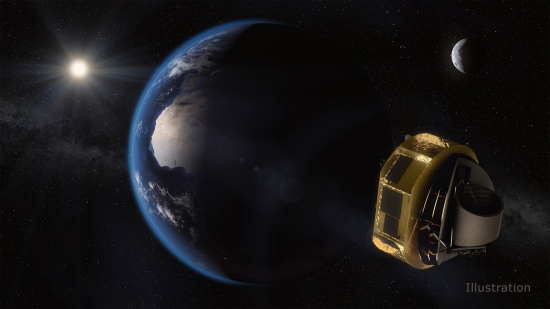
Image: This artist’s concept shows the European Space Agency’s ARIEL spacecraft on its way to Lagrange Point 2 (L2) – a gravitationally stable, Sun-centric orbit – where it will be shielded from the Sun and have a clear view of the sky. NASA’s JPL will manage the mission’s CASE instrument. Credit: ESA/STFC RAL Space/UCL/Europlanet-Science Office.
Remember that while we await the launch of the James Webb Space Telescope, JWST is by no means a dedicated exoplanet mission, though it will work with a small sample of exoplanets for detailed study as it shares observing time with other investigations. The ARIEL team should be able to draw from JWST’s experience as it homes in on a final target list. Keep in mind as well that ESA’s PLATO mission — PLAnetary Transits and Oscillations of stars — is also in the pipeline, slated for a 2026 launch. As I say, the tools are evolving as our focus sharpens.

Finding Alpha Centauri
It’s always breathtaking to see the band of the Milky Way under good viewing conditions. I remember so well the night I saw it best, about 20 years ago on a cold, absolutely clear night from a boat in the middle of Lake George. This is up in New York’s Adirondacks, and when I glanced up as we crossed the lake heading back to our hotel, I was simply stunned by the vista. When you contemplate what you’re looking at and think of yourself within that ghostly band, you feel somehow a deep connection to all the myriad processes that put us here as observing beings.
Now we have another fine view of the Milky Way, this time from TESS. The scientists working data from the Transiting Exoplanet Survey Satellite have just given us a composite drawn from 208 TESS images taken during the mission’s first year of science operations, which ended July 18. Have a look at the southern sky, and realize what while TESS has found 29 exoplanets thus far, another 1,000 or so are in candidate stage and being investigated.
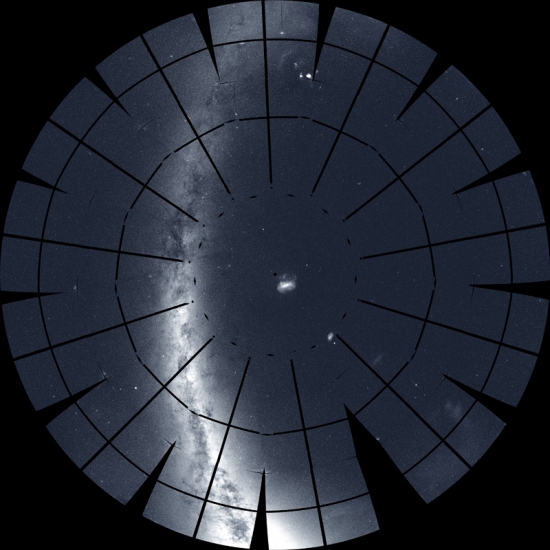
Image: This mosaic of the southern sky was assembled from 13 images taken by NASA’s Transiting Exoplanet Survey Satellite (TESS) during its first year of science operations, completed in July 2019. The mission divided the southern sky into 13 sectors, each of which was imaged for nearly a month by the spacecraft’s four cameras. Credit: NASA/MIT/TESS.
Lots of good things to see here. TESS has divided the southern sky into 13 sectors, each of which received almost a month’s worth of imaging by the four cameras aboard. The Milky Way’s band is easily recognized, but look in the center to see the Large Magellanic Cloud, and at the top of the image, you should be able to identify the Orion Nebula, a birthing place for stars.
Can you find Alpha Centauri in this image? Here’s a second image, one showing the confirmed TESS planets to date. I’ve inserted an arrow to identify our nearest star(s).

Image: The host stars of the 29 TESS planet discoveries to date are shown on this version of the southern sky mosaic. Credit: NASA/MIT/TESS and Ethan Kruse (USRA).
TESS is doing excellent work, capturing a full sector of the sky every 30 minutes as it hunts for exoplanet transits. In the first year of operations, its CCDs captured 15,347 30-minute science images. These make up a part of the more than 20 terabytes of southern sky data returned thus far. The TESS survey of the northern sky is now underway.

Latest Findings from Voyager 2
It’s heartening to consider that the two Voyager spacecraft, though built for a 4 ½ year mission, have continued to function ten times longer than that. This fact, and data from other missions, will help us get a handle on longevity in spacecraft systems as we contemplate pushing out beyond the heliosphere with a spacecraft specifically designed for the job. Mission longevity is mysterious for it often seems to surprise even the designers, who would like to have a more concrete sense of how to ensure operations continue for decades.
Voyager 2 broke Pioneer 6’s record of 12,758 days of operation way back in 2012, but we can also consider spacecraft like Landsat 5, launched in 1984 and carrying two instruments, the Multispectral Scanner System (MSS) and the Thematic Mapper (TM). Managed by the U.S. Geological Survey (USGS), Landsat 5 completed over 150,000 Earth orbits and sent back more than 2.5 million images of Earth’s surface, with operations lasting almost three decades. Design life for Landsat 5 was estimated at three years, but it became, as Guinness World Records labels it, the ‘longest-operating Earth observation satellite.’
While the Landsat accomplishment is significant, the two Voyagers have actually taken us into a new realm, with Voyager 2 joining Voyager 1 beyond the heliosphere on November 5, 2018. Outside the protective ‘bubble’ blown by the stream of particles and magnetic fields from the Sun known as the solar wind, these craft are now the subject of five new research papers in Nature Astronomy describing the data Voyager 2 has returned since the crossing. Have a look at the relative position of the two spacecraft.
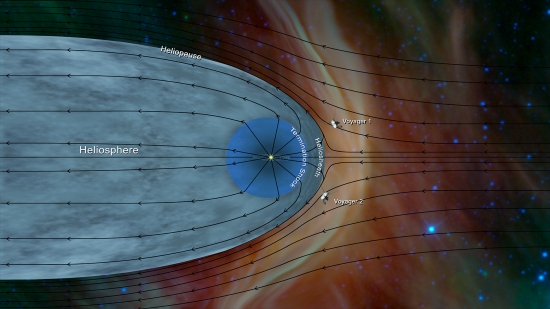
Image: This illustration shows the position of NASA’s Voyager 1 and Voyager 2 probes, outside of the heliosphere, a protective bubble created by the Sun that extends well past the orbit of Pluto. Voyager 1 crossed the heliopause, or the edge of the heliosphere, in August 2012. Heading in a different direction, Voyager 2 crossed another part of the heliopause in November 2018. Credit: NASA/JPL-Caltech.
Note the plasma flow lines both inside and outside the heliopause. Plasma is a gas composed of charged particles, a ‘wind’ that differs in direction depending on whether its source is the Sun or the interstellar medium itself. The Voyagers have two instruments returning data on plasma at the borderline between the Sun’s domain and interstellar space. The data show hot and sparse plasma inside the heliosphere, while interstellar plasma is colder and denser. We learned from Voyager 1 that the heliosphere protects the Solar System from about 70 percent of the incoming cosmic ray radiation, which is made up of particles accelerated by exploding stars.
While Voyager 1 showed higher than expected plasma density just outside the heliosphere (an indication, researchers say, of compression), Voyager 2’s findings demonstrated slightly warmer plasma than expected, while confirming the compression at the edge of the heliosphere. Meanwhile, the spacecraft’s particle instruments (two of the five still operating instruments can detect particles in different energy ranges) showed some particles slipping across the boundary into interstellar space, indicating a more porous boundary in Voyager 2’s location outside the ‘flank’ of the heliosphere, as opposed to Voyager 1’s exit at its front.
Magnetic field issues still raise questions. Voyager 1 had shown that the magnetic field just beyond the heliopause is parallel to the magnetic field inside the heliosphere. Voyager 2’s magnetometer confirms this finding of field alignment. Ed Stone (Caltech) is the all but legendary project scientist for Voyager:
“The Voyager probes are showing us how our Sun interacts with the stuff that fills most of the space between stars in the Milky Way galaxy. Without this new data from Voyager 2, we wouldn’t know if what we were seeing with Voyager 1 was characteristic of the entire heliosphere or specific just to the location and time when it crossed.”
Having two spacecraft leaving the heliosphere has been a tremendous boon for science. Voyager 1 and Voyager 2 exited the heliosphere at different locations as well as at different times in the 11-year solar cycle. The latter keeps the solar wind mutable and frothing, something to be borne in mind when we consider spacecraft designs that could ‘sail’ on this wind, and affects the shape of the heliosphere itself, whose boundaries vary with solar changes. We learn from the new papers that neither Voyager is in undisturbed interstellar space, but rather in a churning transitional region, outside the heliosphere but still affected by its presence.
The papers, all of them in Nature Astronomy‘s October 2019 issue, are Richardson et al., “Voyager 2 plasma observations of the heliopause and interstellar medium”; Krimigis et al., “Energetic charged particle measurements from Voyager 2 at the heliopause and beyond”; Stone et al., “Cosmic ray measurements from Voyager 2 as it crossed into interstellar space”; Burlaga et al., “Magnetic field and particle measurements made by Voyager 2 at and near the heliopause”; and Gurnett & Kurth, “Plasma densities near and beyond the heliopause from the Voyager 1 and 2 plasma wave instruments.”

Gas Giants on Eccentric Orbits: ‘Wrecking Balls’ for the Inner System?
We often think of Jupiter as a mitigating influence on asteroid or comet strikes in the inner system, its gravity changing the trajectories of potential impactors. That would make gas giants a powerful determinant of the survivability of Earth analogues, at least in terms of habitability. While we continue to investigate the question, it’s interesting to consider the damage a gas giant on an elliptical orbit might do to habitable zone planets. Stephen Kane (UC-Riverside), working with Caltech astronomer Sarah Blunt, decided to find out what would happen if, in their modeling, they introduced an elliptical gas giant into the system of an Earth twin.
You may remember Kane’s work earlier this year combining radial velocity with direct imaging methods to find three gas giants that had been previously unobserved (citation below). The monitoring of ten target stars continues even as this new work is published. We’re beginning to find more planets at ever larger distances from their stars as radial velocity and direct imaging methods improve, allowing us to better understand how the architecture of our own Solar System measures up to systems around other stars. Kane and Blunt’s paper implies that a gas giant on an elliptical orbit does not necessarily preclude a habitable planet’s survival.
The planetary system at HR 5183 is a little over 100 light years away in Virgo, home to an eccentric gas giant in a 75 year orbit that the researchers used in their modeling. The primary here is a G-class star. Its planet has one of the longest orbital periods currently known among exoplanets. The eccentricity of this world is e = 0.84, where e = 0 would be perfectly circular, and e = 1 would be a line segment. To find out whether such a world really would be a ‘wrecking ball’ for its neighbors, the researchers introduced a habitable zone terrestrial world as a test case to study extreme system architectures and their effects on habitability.
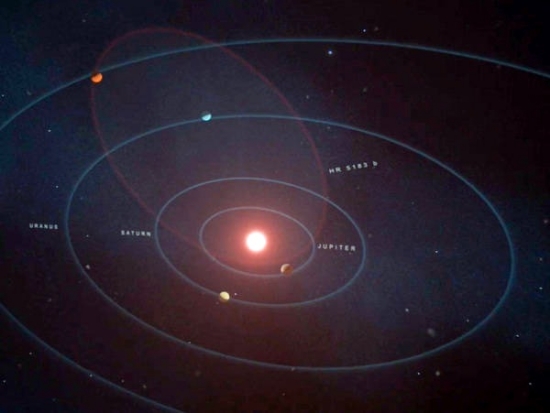
Image: Comparison of HR 5183b’s eccentric orbit to the more circular orbits of the planets in our own solar system. Credit: W. M. Keck Observatory/Adam Makarenko.
The dynamical simulations here involved the exploration of 200 evenly spaced semi-major axes between 1.0 and 3.0 AU, intended to encompass the range of the optimistic habitable zone around such a star. Kane and Blunt then placed an Earth-mass planet at randomized starting positions and propagated the effects of the eccentric gas giant over time. Says Kane:
“In these simulations, the giant planet often had a catastrophic effect on the Earth twin, in many cases throwing it out of the solar system entirely. But in certain parts of the planetary system, the gravitational effect of the giant planet is remarkably small enough to allow the Earth-like planet to remain in a stable orbit.”
This being the case, we’re called upon to imagine the view from the surface of a habitable zone planet in this system. The gas giant is on a 75 year orbit, something akin to Halley’s Comet in our own system. Kane says that when the gas giant makes its closest approach to the terrestrial planet during that orbit, it would appear 15 times brighter than Venus, a spectacular object that would dominate the night sky before receding once again into the outer reaches.
Here’s a clip from the paper talking about the significance of these findings. Note that the Milankovitch cycles discussed below are cyclical movements — eccentricity, axial tilt, and precession — related to a planet’s orbit around a star. From the paper:
The importance of such systems from a planetary habitability perspective arises from a thorough investigation of the dynamical stability of terrestrial planetary orbits, such as the one presented here. The careful analysis of the dynamical integrations demonstrates that planets can survive within a narrow range of locations in the HZ of such systems, even in the presence of a wrecking ball whose orbital origin is likely a chaotic event involving vast exchanges of angular momentum.
So we have planetary survival in certain locations, but habitability is severely challenged:
…the case of the HR 5183 system also shows that the presence of an eccentric planet will often have a profound effect on the Milankovitch cycles of the HZ terrestrial planetary orbits, causing significant orbital oscillatory behavior. The implications for the climate effects on such worlds may rule out temperate surface conditions, although the stabilizing effects of surface liquid water oceans can also potentially prevent a climate catastrophe.
In other words, our terrestrial world in its habitable zone orbit in a system with a highly eccentric gas giant is in a dangerous position indeed, though not one that completely rules out life. This seems to represent a slight widening of habitable zone possibilities as we examine exoplanetary systems, though the ‘wrecking ball’ hypothesis still seems the most likely outcome.
The paper is Kane & Blunt, “In the Presence of a Wrecking Ball: Orbital Stability in the HR 5183 System,” Astronomical Journal Vol. 158, No. 5 (31 October 2019). Abstract / Preprint. The paper on gas giant detection is Kane et al., “Detection of Planetary and Stellar Companions to Neighboring Stars via a Combination of Radial Velocity and Direct Imaging Techniques,” accepted at the Astronomical Journal. Preprint.

Benefits of a ‘Snow Line’ Neptune
The formation of planets like Neptune under the core accretion model involves a protoplanetary core that reaches around 10 Earth masses before beginning to pull in surrounding gas, the latter being a runaway process that quickly builds the atmosphere around the object. Core accretion is most efficient at doing this just outside the snow line, but if we want to understand and test the theory, we need to know a lot more about how planets are distributed in this region.
And that’s a problem, because recent microlensing surveys have found that planets like Neptune are most abundant much more distant from their host stars. Outward migration can account for such worlds, but we know little about exoplanets that form at the snow line, which is where the condensation of ices can factor into the emergence of a new world.
Is this just an artifact of our still evolving microlensing detection techniques? Perhaps, and exceptions to the rule can therefore be helpful. Recent work that began with a discovery by a Japanese amateur astronomer has now blossomed into a full-scale study of a snow line Neptune around a star that, unlike most viewed by microlensing, is actually fairly close. The amateur, Tadashi Kojima in Gunma Prefecture, Japan, found the object in Taurus, the beginning of observations from numerous observatories that uncovered the microlensing behind the discovery.
The planet Kojima-1Lb orbits a star 1600 light years away, while the star it passed in front of is some 2600 light years out. Remember that the curvature of spacetime in the presence of massive objects accounts for this phenomenon, as warped space around the nearby star acts as a lens that focuses the light from the background star. Within this brightening, a transient but useful phenomenon, changes in intensity can reveal a planet orbiting the foreground star, as happened here. This discovery is unusual because most microlensed planets have been observed toward galactic center, which makes sense given the sheer abundance of stars there. This one is found close and toward the galactic anticenter.
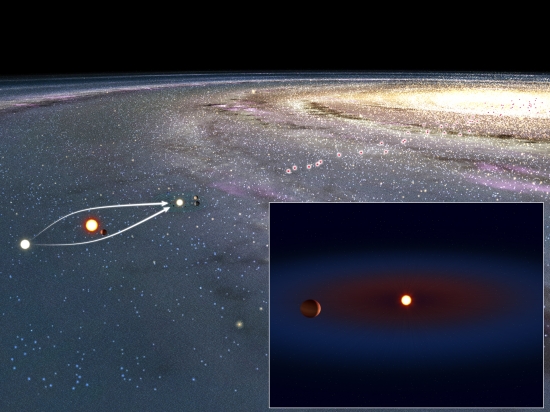
Image: Diagram illustrating the microlensing event studied in this research. Red dots indicate previous exoplanet systems discovered by microlensing. Inset: Artist’s conception of the exoplanet and its host star. Credit: The University of Tokyo.
76 days of observation by a team led by Akihiko Fukui at the University of Tokyo took advantage of 13 telescopes around the world, including two at the National Astronomical Observatory of Japan’s Okayama Astrophysical Observatory. The work, as revealed in a paper just published in the Astronomical Journal, show a Neptune-class planet orbiting a star on the border line between K and M-class dwarf status. The planet is about 20 Earth masses and orbits at 1.08 AU, snow line distance for this system.
So we’ve got a helpful Neptune at the snow line. The paper draws an interesting but highly tentative conclusion from this detection:
The orbit of Kojima-1Lb is a few times closer to the host star than the other microlensing planets around the same type of star and is likely comparable to the snow-line distance at its youth. We have estimated that the detection efficiency of this planet in this event is ?35%, which may imply that Neptunes are common around the snow line.
In other words, Fukui and colleagues calculate the a priori detection probability of this kind of planet at 35 percent, making this chance detection a possible indication of an abundance of such worlds around the snow line of other stars. The paper goes on to point out that the host star here is the brightest among all those studied in microlensed systems, offering the opportunity to do follow-up spectroscopic analysis to characterize the host star and to refine both mass and orbit of the planet through radial velocity studies.
The paper is Fukui et al. “Kojima-1Lb is a Mildly Cold Neptune around the Brightest Microlensing Host Star,” Astronomical Journal Vol. 158, No. 5 (November 1, 2019). Abstract / preprint.

Engineered Exogenesis: Nature’s Model for Interstellar Colonization
Is seeding life into the universe to be a part of the human future? Space probes conceivably could be doing this inadvertently, and the processes of panspermia also may be moving biological possibilities between planets and even stars. Robert Buckalew has his own take on what humans might do in this regard, as discussed below. Robert has written fiction and non-fiction since 2013 under the pen name Ry Yelcho for the blog Yelcho’s Muses. In 2015 he received the Canopus Award for Excellence in Interstellar Fiction from 100 Year Starship for the story “Everett’s Awakening.” His short story “The Interlopers” appears on Literally Stories. What follows draws on his speculative science article “Microbots—The Seeds of Interstellar Civilization,” which was awarded the Canopus Award for Original Non-Fiction. The essay that follows is based on his presentation at the Icarus Interstellar Starship Congress 2019.
by Robert Buckalew
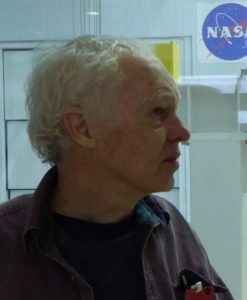
The series of pivotal events that led to the development of intelligent life on Earth are so numerous and seemingly random that the occurrence of intelligent life at other places in the galaxy may be very rare. The chance extinction of the dinosaurs which led to the diversification and opportunistic evolution of mammals is but one of many such events. Assuming the extraordinary rarity of this occurrence elsewhere in the galaxy should be a compelling reason for humans to presume our gifts of intellect exceptional and assume the obligation to prevent this cosmic largess from vanishing through global natural disaster, nuclear war or self-made neglect. Even if intelligent life is found to be common in the universe, it is certain that our form of intelligent life is unique. If we wish, someday, to communicate and interact with these various sentient species and contribute our singular human culture to their diverse communities, we must project our species’ existence into cosmic time frames.
The creation of dispersed, self-sufficient human settlements both interplanetary and extra-solar is the best way to ensure our long term survival as a species. Because of the unimaginable distances to other star systems, most proposals for interstellar colonization involve large multi-generational starships, warp drives or wormholes. Although common plot devices to create science fiction stories, wormholes and warp drives appear unworkable travel methods given the constraints of known physics. Multi-generational starships come with their own technological, political, biological, social and psychological challenges that make their realization daunting to consider.
Nature, however, has developed efficient methods to spread life on Earth that could be employed for interstellar colonization. Engineered Exogenesis, modeled after successful natural processes, proposes a method to spread Earth-life throughout our local stellar neighborhood.
Exogenesis, in astrobiology, is the hypothesis that life originated elsewhere in the universe and was conveyed here to Earth. For example, there is evidence that life in our solar system originated on Mars and was brought to this planet aboard a meteorite. The plausibility of Earth-life having been transplanted is supported by our inability to create spontaneous life from primordial organic chemicals in the laboratory and by the fact that there is no known remnant of pre-genetic life on Earth.
Engineered Exogenesis will use an additional strategy derived from nature. The survival system used by plants, insects and many aquatic lifeforms is based on the overproduction of seeds, larvae or spores in order to overcome their natural failure rate. Mass produced microbots can be designed to intentionally deliver engineered genetics to prospective exoplanets in numbers sufficient to assure that some will likely reach their destination and survive. As with seeds, this may require the dissemination of thousands to millions of them, based on the projected failure rate of the delivery system and the expected germination rate.
We know that water and organic compounds, known as tholins, have been found on planets, moons, comets and asteroids throughout our solar system. These precursors for life are believed to exist on interstellar comets and asteroids as well. Planetary exo-systems are expected to offer a similar fertile environment ready for the introduction of earthly genetic material.
The major components of an Engineered Exogenesis system might include 1) a microbiotic vessel that travels to the extra-solar planet, 2) a space-based magnetic accelerator capable of providing the inertial energy to send the vessel to other solar systems, 3) a space-based laser providing communication and supplemental energy for solar sail navigation and maneuvering, and 4) the engineered genetic material capable of growing a bio-robotic agent on the exoplanet to prepare the planetary environment for humans.
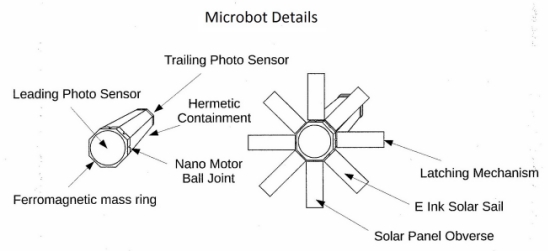
The Microbot
The microbiotic vessel, hereafter referred to as the microbot, would transport hermetically encapsulated, genetic material to the destination exoplanet while providing radiation, magnetic and acceleration protection. This vessel would be designed to open in the presence of liquid water, deploy a biobot zygote and, if necessary, a photosynthesizing food source such as phytoplankton or other aqueous plant food. The engineering of the microbot would incorporate nano technology, bio-robotics, AI and neural networks. It could be very small, possibly the size of a grain of rice, and constructed of low mass materials to minimize the energy required for acceleration. Construction materials might include carbon fiber, graphene or Kevlar designed to withstand the high magnetic fields and high acceleration rates and to provide heat shielding for atmospheric entry. Microbot vessels would possess no on-board propulsion using only their initial inertial energy for space travel. A ferromagnetic mass at the leading end of the vessel would be required for magnetic acceleration and inertial stability. This mass might be separated for deceleration upon arrival at the planetary system or retained for atmospheric entry shielding.
Microbots would also use leading and trailing photo-sensors for navigational aids with the leading photo-sensor directed at the destination star and the trailing sensor pointed at Sol. Fore and aft modulated, bio-luminescent lasers would provide communication between traveling microbot ships reminiscent of fireflies on a summer night.
A series of pivoting, flat panels would be extended following launch. Each panel would use one side for solar energy collection. Solar electric storage might be achieved by capacitance of the microbot body. The obverse side, capable of adjustable reflectivity, would be used as a solar sail. The panel ends would also be capable of latching with other microbot panels for the creation of microbot arrays, connected clusters of individual microbots. A powdered iron substrate layer which would become magnetized during acceleration could aid in microbot arraying and later become a magsail for magnetic braking. A superconducting loop for magnetic braking could be incorporated into the perimeter of the solar panels or otherwise deployed as an independent loop. Finally, the panels could be positioned for autogyro aerobraking during atmospheric entry in the same way maple seeds can dissipate energy by helicoptering to Earth.
The Accelerator

Magnetic acceleration happens by activating each electromagnet ahead of the projectile to pull it forward. As the projectile accelerates, the rate of coil activation increases to stay ahead of the accelerating mass. Projectile acceleration would be limited by the inertial mass of the projectile and the force produced by the electromagnets. Magnetic accelerators can include a circular or linear motor configuration.
Aimed at the destination star, the microbots would be accelerated sequentially for a maximum exit velocity with a minimum energy expenditure. This must be a space based as the atmospheric heating from the very high exit velocity precludes microbots being launched from Earth. By timing the sequencing of the magnets the rate of acceleration can be optimized for the given projectile mass and the vulnerability of the vehicle and payload to the forces of acceleration. The length of a linear accelerator is inversely related to the acceleration needed for a given exit velocity – the longer the coil gun, the less acceleration needed. A circular, toroidal accelerator would not have this length constraint as it could use multiple cycles to obtain projectile terminal velocity. Once the system is deployed it could be used for numerous target stars. If microbots can be accelerated to 10% light speed, a trip to Alpha Centari (4.37 light years away) would take 43 years and a trip to Tau Ceti (10.4 light years away) would take 104 years. Reaching these speeds would be a function of the length and power of the accelerator and the mass of the microbot ship.
The Laser
The laser is not for propulsion, as suggested by Yuri Milner’s Breakthrough Starshot, but would be used for communication and programming updates by modulation of the laser beam. It could also provide energy for course correction and arraying maneuvers. It is also best located in space to reduce atmospheric light scattering.
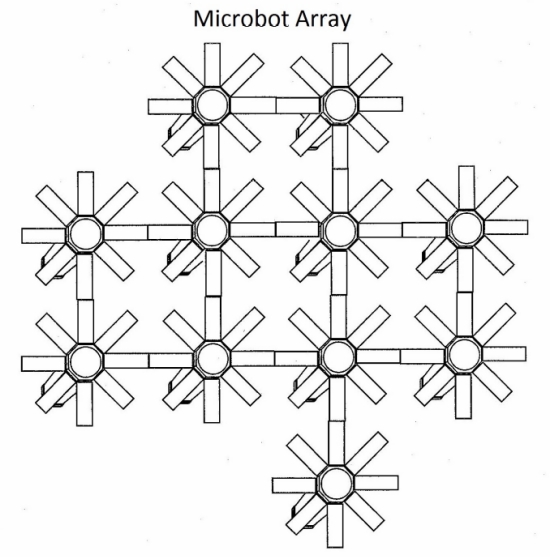
Arrays
Microbots would be programmed to array although some microbots would necessarily remain as self sufficient individual ships. The primary purpose of arraying is to improve communication with Earth as a larger antenna area can enhance both transmission and reception performance. However, arraying may also be used to collectivize the solar power and energy storage and to organize the use of this power.
Implementing Arrays
Microbot arraying could be achieved through use of swarm intelligence, a naturally occurring function among social insects, migrating birds and fish schools. Known in robotics as distributed AI, microbots could communicate with each other while traveling in space through their fore and aft photo-sensors and modulated bio-luminescence. As the trip may take 100 years or more, there should be adequate time for arraying even considering the limited maneuvering power provided by the angular incident positioning and variable reflectivity of their panels. Although launched individually, the first vessels would be accelerated at a slower velocity than the later vessels causing their clumping in space as they travel and increasing their ability to form arrays.
Microbots Arrival and Descent to the ExoPlanet
Deceleration from near relativistic speeds to that of planetary orbit velocity is always problematic. Explosive ejection of the leading ferromagnetic mass could substantially decelerate the containment vessel while reducing the remaining microbot maneuvering mass. Employing the resistance of the reflective solar sails and the magsail, braking and maneuvering could be achieved by using the retrograde radiant photon pressure, plasma energy streams and charged magnetosphere of the destination star. Solar and magnetic braking could continue after entering an elliptical orbit of the star, until a matching planetary orbital velocity is obtained. With aerobraking the arrays could go from an elliptical orbit of the planet to a circular one. For the solitary microbots aerobraking would slow them for atmospheric entry.
Microbots entering the atmosphere would experience further braking through atmospheric drag. With reduced velocity, low gravitational attraction and high surface-to-mass ratios, atmospheric entry damage to the microbots might be kept to a minimum. Descent might be further dampened and controlled by positioning the panels for autogyro energy dissipation.
Engineered Genetic Materials
Genetics has become a game-changing technology allowing for man-made biological creativity. Genetic engineering has been revolutionized through CRISPR and the creation of artificial life by scientists like Craig Venter. Expanding the genetic alphabet beyond the 4 chemical bases found in DNA could add functions capable of assembling metal or silicon components into planet inhabiting biobots.
Although the microbot starship incorporated some bio-robotic functions such as neural networks and bio-luminescence for communication, it did not need the biobot ability to grow and reproduce. The biobots used for planetary exploration, terraforming and habitat construction would be grown from the genetic material in the microbot after acquiring a suitable watery environment for germination/gestation. These bio-life forms would be genetically designed to be suitable for the anticipated planetary environment but might also incorporate a greater degree of robotics into their biology for laser communication with Earth and reprogrammability.
Essential BioBot Characteristics
The first terrestrial biobots might best be designed to be amphibious for food access and terrain mobility and cold blooded for temperature tolerance. They might be capable of solar power or photosynthesis for their energy, but separate genetic material may be included to produce a photosynthesizing food source for the biobots.
Their instinctive behavior would include a work activity for communication and infrastructure building similar to instinctive nest, hive or web building found with Earth life. Their behaviors would be re-programmable from Earth allowing task changing capability. For this they would require a means to transmit and receive laser modulated signals with Earth as well as their interspecies communication using sound or light modulation.
Reproduction could be biological though it would likely be asexual. Reproduction would also be programmable through Earth communication in order to create a series of diverse offspring, specifically-tasked and specialized biobots. Eventually there would be terraforming for human habitation. After successful habitat construction and terraforming, the final genetic download would be human genomes for incubation. This would require specialized biobots for human gestation and nurturing. These humans could be genetically designed for the gravity, atmosphere and temperatures of the exoplanet by adjusting metabolism rate, body mass, lung capacity, skin color, fat, fur covering, etc. These modifications would prognosticate natural changes which would have evolved over time in humans in adapting to their new environment.
The simpler alternative to the more complex remote reproductive reprogramming would be to send sequential waves of microbots each containing subsequent genetics. However, the advantages of remote genetic reprogramming would not only result in faster colonization, but the genetic developments during the 100+ year microbot travel time could be incorporated in the transmitted genetic code.
Advantages of Engineered Exogenesis
There are some obvious advantages that come with with an Engineered Exogenesis approach to interstellar colonization. It would be scalable, specifically, the numbers of microbots manufactured and launch frequencies can be adjusted to suit political or financial circumstances. It would not be limited to one target planet, and any number of planets or newly discovered planets or moons could be added as targets over time. It would be tested in our solar system and modified with improvements before deployment. The seeding and growth of biobots could take place on Earth or in domed environments on the moon or Mars. Finally, it reduces the time scale for starship colonization, and eliminates human exposure to space travel. It, however, it lacks the drama and romance found in human adventure stories in space.
For Engineered Exogenesis to become a reality there are many technical problems to be resolved as well as numerous ethical issues to be considered such as the chauvinistic imposition of our genetics onto other evolving planetary systems, the creation and dissemination of synthetic, reproducing life forms and the alternation of our own human genome. Society, so far, has been accepting of test tube babies, GMO food crops and gene therapy, especially when it seems to improve our lives. Such controversial technological impositions may also be accepted as necessary in order to achieve a human interstellar presence.
Has This Happened Before?
If Engineered Exogenesis is a viable idea, would it not have been done by advanced alien civilizations? If so, why are there no alien biobots roving around on Earth? This is like the Fermi Paradox about space aliens. If they were sent here, maybe ocean Earth life feeds on these undeveloped alien genomes before they grow and reproduce. Possibly life on Earth is the result of an alien exogenesis. Then where are the microbot ships that carried them? They would be tiny, widely scattered and hard to find. Possibly the nascent search for micrometeorites on Earth may yet find one of these artificial nanobots.
References
1. Michael Noah Mautner, “Seeding the Universe with Life: Securing Our Cosmological Future,” The Interstellar Panspermia Society. http://www.panspermia-society.com/
2. N. Mathews, A. L. Christensen, R. O’Grady, F. Mondada, and M. Dorigo, “Mergeable nervous systems for robots,” Nature Communications 8(439), 2017 (full text).
3. Jennifer Doudna, “How CRISPR lets us edit our DNA,’ TED Talk September 2015. https://www.ted.com/talks/jennifer_doudna_we_can_now_edit_our_dna_but_let_s_do_it_wisely?language=en
4. J. Craig Venter, “Watch me unveil ‘synthetic life,'” TED talk. May 2010. https://www.ted.com/talks/craig_venter_unveils_synthetic_life?language=en
5. Daniela Rus, “Autonomous boats can target and latch onto each other,” MIT News June 5, 2019. http://news.mit.edu/2019/autonomous-robot-boats-latch-0605
6. Sarah Hörst, “What in the world(s) are tholins?” Planetary Society July 22, 2015. http://www.planetary.org/blogs/guest-blogs/2015/0722-what-in-the-worlds-are-tholins.html
7. Francesco Corea, “Distributed Artificial Intelligence: A Primer on Multi-Agent Systems Agent Based Modeling and Swarm Intelligence,” https://www.kdnuggets.com/2019/04/distributed-artificial-intelligence-multi-agent-systems-agent-based-modeling-swarm-intelligence.html
8. Paul Gilster, “Starship Surfing: Ride the Bow Shock,” Centauri Dreams March 21, 2012 https://www.centauri-dreams.org/2012/03/21/starship-surfing-ride-the-bow-shock/


